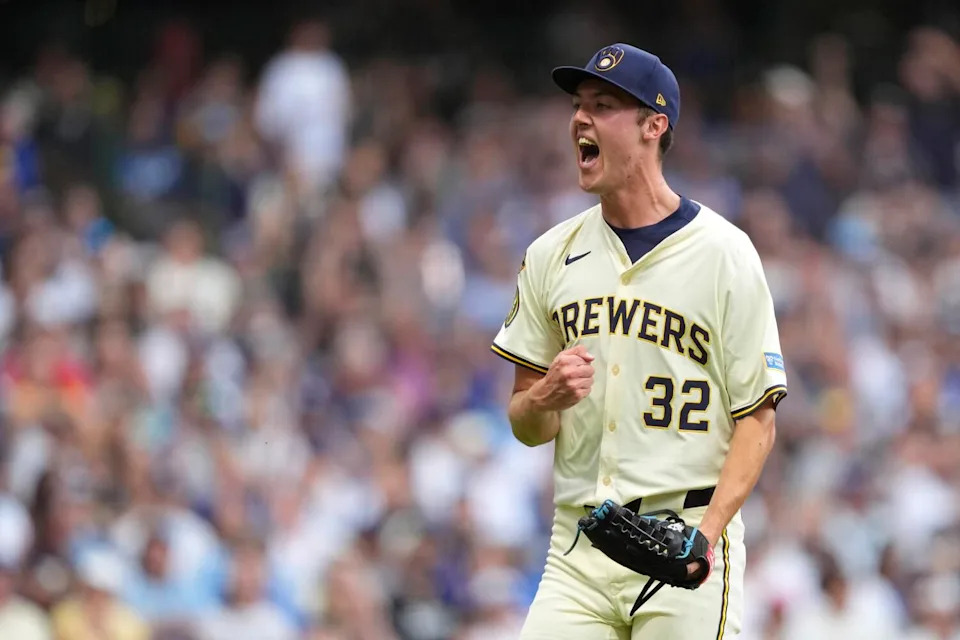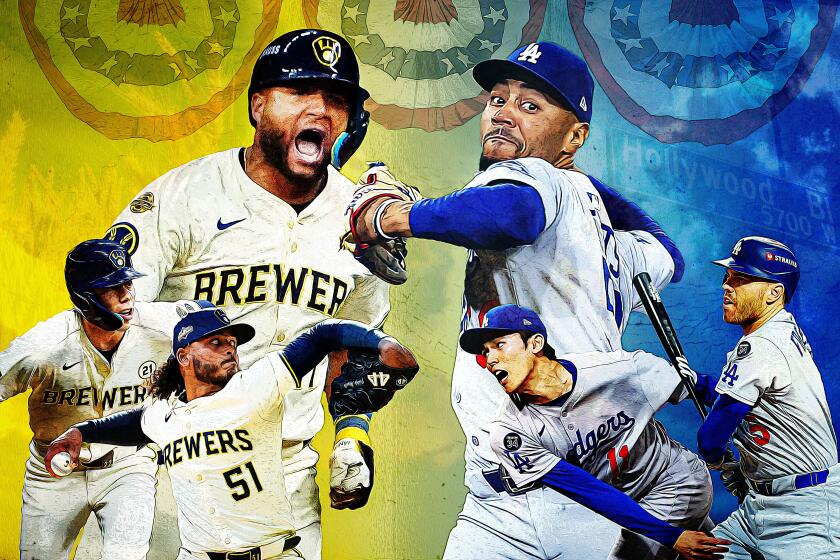The Dodgers were on double duty Saturday night.
As they worked out at Dodger Stadium, two days after winning their National League Division Series over the Philadelphia Phillies, they had Game 5 of the other NLDS on the scoreboard — getting a first look at their NL Championship Series opponent.
“It’s certainly nice to be able to get a couple days to reset, prepare, and we’re kind of doing our due diligence,” manager Dave Roberts said on Saturday afternoon. “We’ll have that game on the big board.”
What they saw as they worked out was a 3-1 Milwaukee Brewers win that sets up an NLCS opener on Monday at American Family Field.
Read more: Can Shohei Ohtani find it at the plate for NLCS? ‘At-bat quality needs to get better’
As of Saturday, the Dodgers were awaiting their opponent before picking a Game 1 starter or finalizing their NLCS roster.
Now, they know who they’ll be facing with a trip to the World Series on the line.
Ahead of this week’s NLCS, here are nine things to know about the Brewers:
An identifiable brand
The Brewers’ $143-million payroll this year was less than 20 other teams in Major League Baseball — including the historically bad Colorado Rockies — and almost one-third the size of the Dodgers.
That meant, in lieu of star talent and potent offensive weapons, the Brewers had to build their team around playing a particular brand of baseball. And on offense, where they were third in the majors in scoring this year, that led them to go all-in on a small-ball approach.
Read more: Shaikin: Are these the real Dodgers? Why a ‘whole other level’ could emerge in the NLCS
They got on base, ranking third in batting average (.258) and fourth in walks. They swung at good pitches, recording the fifth-fewest strikeouts while chasing out of the zone at the lowest rate in MLB. They made contact (with the majors’ third-lowest whiff rate) and put pressure on defenses (ranking second in stolen bases). They had the second-best batting average with runners in scoring position, as well.
It didn’t matter that they were only 22nd in home runs, or 12th in slugging percentage. Only 33% of their runs scored came via big flies anyway (the third-lowest mark in MLB).
Instead, they built a lineup full of tough outs and hitters who didn’t deviate from the team-wide plan. They formulated an identity, and rode it to the winningest season in their franchise’s history at 97-65.
An old-school manager
Milwaukee Brewers manager Pat Murphy returns to the dugout after making a pitching change during a July 2024 game. (Erin Hooley / Associated Press)
If that style sounds almost collegiate in nature, it’s because it emanated from the Brewers’ old-school, former college coach of a manager.
After helming big-name college programs at Notre Dame and Arizona State for three decades, the 66-year-old Pat Murphy has become one of the most beloved characters in professional baseball in recent years.
He joined the Brewers in 2016 as bench coach for Craig Counsell. When Counsell left two years ago for the Cubs (the team Milwaukee beat in the NLDS), Murphy was promoted to the big chair.
Now, he’s become known for his big personality, his hands-on approach in molding Milwaukee’s brand of baseball … and more lighthearted habits, like the “pocket pancakes” he’ll gobble up in the middle of games.
An impeccable pitching staff
For all the attention the Brewers’ unique offense and one-of-a-kind manager have received this year, the club’s pitching staff remains the backbone of the team.
The Brewers, long known for their ability to develop pitching talent and replenish staff depth despite their shoestring budget, ranked second in the majors in team ERA this season, third in batting average allowed and fifth in strikeouts.
Like with the offense, it required full-team production. The Brewers’ rotation had the third-best ERA, but logged the fifth-fewest innings. Their bullpen, however, was sixth in ERA and fifth in save percentage.
The Dodgers learned this first-hand this year, when they were twice swept by Milwaukee in July. In those six games, the Dodgers scored just 16 runs, nine fewer than they managed against any other NL team. They also batted .179, lower than any other opponent they faced besides the Texas Rangers.
The NL wins leader
The Brewers’ one true ace this season was veteran right-hander Freddy Peralta, a two-time All-Star who turned in a career-best performance with a 2.70 ERA, an NL-best 17 wins in 33 starts, and a whopping 204 strikeouts in just 176 ⅔ innings (the sixth-best K/9 mark in MLB).
Read more: Hernández: Roki Sasaki’s playoff dominance shows why he’s the Dodgers’ future staff ace
Peralta was Milwaukee’s starter in Game 1 of the NLDS, when he struck out nine over a 5 ⅔ innings, two-run start. He’d likely get the Game 1 nod again in the NLCS, where the Dodgers will have to prepare for his deceptive mid-90s-mph fastball (which limited hard contact and held opponents to just a .209 average in the regular season) and a changeup/curveball/slider secondary mix (which induced whiffs on more than one-third of swings).
Peralta made two starts against the Dodgers this year, tossing six shutout innings on July 7 in Milwaukee before giving up four runs in five innings two weeks later at Dodger Stadium.
The late-blooming talent
At the start of this season, former first-round draft pick Quinn Priester was looking more like a bust than a future postseason rotation member.
After posting a 6.23 ERA in his first two big-league seasons with the Pittsburgh Pirates and Boston Red Sox, the Brewers acquired the 25-year-old right-hander in April for two minor-leaguers in hopes he could provide rotation depth.
Instead, he became their second-best starter.
Priester’s postseason debut did not go well, giving up four runs in the first inning of Game 3 before being removed after just two outs.
But in 29 regular-season outings, Priester had a 3.32 ERA with a 13-3 record that marked the highest winning percentage in the majors. He doesn’t strike out many batters (just 132 in 157 ⅓ innings) or throw the ball exceptionally hard (his fastball sits 94 mph). But he had one of the best ground-ball rates in the sport thanks to a sinker he used more than ever before in his career.
The rookie All-Star

The Milwaukee Brewers’ Jacob Misiorowski reacts after striking out the Dodgers’ Freddie Freeman during a game on July 8. (Aaron Gash / Associated Press)
Remember Jacob Misiorowski? The rookie phenom who earned an unexpected All-Star selection (just five starts into his career) after dominating the Dodgers in a 12-strikeout gem in early July.
Well, it turned out he wasn’t the second-coming of Paul Skenes, stumbling to a 5.36 ERA over the rest of the season (while battling a shin injury) that landed him in Milwaukee’s postseason bullpen.
However, the 6-foot-7 flamethrower made a huge impact in the NLDS, throwing three scoreless innings of relief in Game 2 and four more in the winner-take-all Game 5.
He once again figures to play a key role in the NLCS. And whether or not he can replicate his dominance against the Dodgers could be an X-factor in the series.
Depth on depth on depth
Beyond the above names, the Brewers pitching staff just keeps coming in waves.
There is crafty veteran left-handed starter Jose Quintana (11-7, 3.96 ERA), who has long been a thorn in the Dodgers’ side (2.32 ERA in 15 outings against them).
There is a hard-throwing bullpen hierarchy of Trevor Megill (30 saves, 2.49 ERA), Abner Uribe (seven saves, 37 holds, 1.67 ERA) and left-hander Jared Koenig (two saves, 27 holds, 2.86 ERA).
There are productive middle relievers in Grant Anderson and Nick Mears (right-handers with 60-plus appearances and sub-3.50 ERAs) and Aaron Ashby (another lefty with a 2.16 ERA, but who struggled as an opener in the NLDS).
It means, even in a seven-game series, there could be few weak spots in the Milwaukee pitching staff for the Dodgers to exploit.
Depth on depth at the plate too
Back to the offense, where the Brewers make up for their lack of big names with equally impressive offensive depth.
Christian Yelich is the club’s one household name. The former MVP hit .264 with team-highs in home runs (29) and RBIs (103) while serving primarily as designated hitter. Jackson Chourio is a former top prospect with an $82-million contract, coming off a .270 season with 21 home runs and 78 RBIs.
Beyond them, however, the Brewers have plenty of other contributors.
Read more: Tommy Edman and Andy Pages put struggles aside to be key part of decisive Dodgers’ inning
Second baseman Brice Turang hit .288 with 18 home runs. Outfielder Isaac Collins, a 28-year-old rookie, batted .263 with 22 doubles. Former Chicago White Sox slugger Andrew Vaughn was acquired in a midseason trade after being demoted to the minors, then blossomed with a .308 average and 46 RBIs, starting with a breakout series against the Dodgers in July. And then there’s catcher William Contreras, who hit .260 with 17 home runs.
Home-field advantage
The Brewers locked up the best record in baseball, and home-field advantage throughout the playoffs, thanks largely to how well they played at their home field.
The team’s 52 home wins trailed only the Philadelphia Phillies and Toronto Blue Jays for most in the majors, tying the Dodgers for second-most in the NL. And in the NLDS, they went 3-0 at American Family Field.
That’s where the NLCS will open on Monday night.
Sign up for more Dodgers news with Dodgers Dugout. Delivered at the start of each series.
This story originally appeared in Los Angeles Times.
Read the full article here

